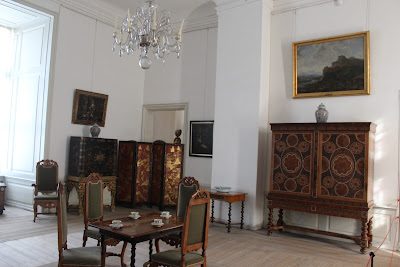16 September, 2012.
Another day, another Slot.
This time to Helsingør - the home of Hamlet, Holger the Dane and Han (the merman).
 |
| Helsingor |

 |
Cannons pointing straight at Sweden.
I can't help but think that if given the opportunity, Denmark would have a red-hot go at invading Sweden. |
Culturally, Kronborg is an important site for Danes, not only because it is the home of the legendary Danish prince, Hamlet, but also of Holger the Dane. Holger the Dane, according to myth, had a son who was killed by Charlemagne's son Charlot. Holger then killed Charlot out of revenge and spent around seven years fighting with Charlemagne before throwing in the towel and forming an alliance with him against the Saracens. There is a massive statue of Holger in the casemates
of Kronborg. It is said that if the Danish kingdom is ever threatened, the statue will come to life and defend his country.
 |
| Me and my homeboy, Holger. |
 |
| In the casematis. |
It is a pity that I had been to Frederiksborg Slot the day before Kronborg, because when compared with the extravagance and elegance of Frederiksborg, Kronborg seems painfully plain. There are no pastel walls, or elegantly carved wooden fixtures. Instead, there are spartan stone walls and unvarnished wooden floors. The furniture was simple and the colours were absolutely minimal. The only hint of decoration in the entire palace was in the few threadbare tapestries that adorned the walls.
 |
| The Queen's Chamber. |
These tapestries are threadbare because they were commissioned in the mid 1500s as a bit of a pissing contest with the Swedes. The Swedish king at the time had ordered his own set of tapestries to represent nearly 150 Swedish kings throughout the eras (FYI, Noah was a Swedish king). While the Danes could only muster 115 kings in their line (clearly, the Ark didn't make it all the way around the Baltic Sea), they did choose a better weaver because while Sweden only had 4 completed tapestries, the Danes accumulated 40. While most the tapestries were destroyed in the fire, 14 originals survived and are displayed in Kronborg.
 |
One of the surviving tapestries.
Fun fact: The Swedes took this tapestry, but when they took it, tapestries were out of fashion for palace decoration, so they just put it in a box for a few decades, just to stick it to the Danes. |
 |
| The tapestries. |
ps. Gift shops are fun

































No comments:
Post a Comment